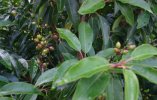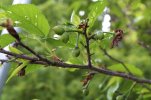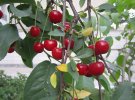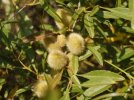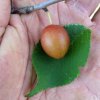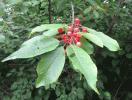Navigation
Install the app
How to install the app on iOS
Follow along with the video below to see how to install our site as a web app on your home screen.
Note: This feature may not be available in some browsers.
More options
Welcome to our Forums!
Type /register while in-game to register for a forum account.
You are using an out of date browser. It may not display this or other websites correctly.
You should upgrade or use an alternative browser.
You should upgrade or use an alternative browser.
Posting a different fruit every day until we obtain a Crypt head
- Thread starter Evil_X
- Start date
October 25th, Day 1447: Prunus mume
Fruit Info: For our next fruit of the day, we have this lovely cherry relative known as the Japanese Apricot or as the Chinese Plum, depending on who you’re talking to and where you are. This fruit is used for juices, pickles, sauces and as a pickle.
Fruit Tier: A
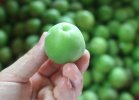
Fruit Info: For our next fruit of the day, we have this lovely cherry relative known as the Japanese Apricot or as the Chinese Plum, depending on who you’re talking to and where you are. This fruit is used for juices, pickles, sauces and as a pickle.
Fruit Tier: A

October 26th, Day 1448: Prunus x dasycarpa
Fruit Info: For our next fruit of the day we have the purple apricot, which can also be referred to as the black apricot. There is disagreement about whether or not this is a human created cross or a naturally occurring one. Either way it originates from Western Asia.
Fruit Tier: B
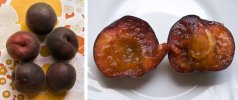
Fruit Info: For our next fruit of the day we have the purple apricot, which can also be referred to as the black apricot. There is disagreement about whether or not this is a human created cross or a naturally occurring one. Either way it originates from Western Asia.
Fruit Tier: B

October 27th, Day 1449: Prunus ulmifolia
Fruit Info: Today we have another relative of the plum, apricot, and cherry, belonging to the same genus. This fruit is a native of east Asia. It is often treated as the same fruit as a close relative of its, but there are key differences between the plants that grow them. In addition, this fruit doesn’t split when ripe unlike its relative.
Fruit Tier: B
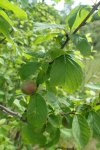
Fruit Info: Today we have another relative of the plum, apricot, and cherry, belonging to the same genus. This fruit is a native of east Asia. It is often treated as the same fruit as a close relative of its, but there are key differences between the plants that grow them. In addition, this fruit doesn’t split when ripe unlike its relative.
Fruit Tier: B

October 29th, Day 1451: Prunus pumila
Fruit Info: The fruit you see pictured below here is what is commonly referred to as the sand cherry. It is a North American species of cherry that is widespread across much of eastern and central Canada. It often grows in sandy locations suck as shorelines and dunes.
Fruit Tier: C
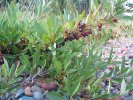
Fruit Info: The fruit you see pictured below here is what is commonly referred to as the sand cherry. It is a North American species of cherry that is widespread across much of eastern and central Canada. It often grows in sandy locations suck as shorelines and dunes.
Fruit Tier: C

October 30th, Day 1452: Prunus tomentosa
Fruit Info: The Nanjing cherry is our newest fruit of the day to add to our ever growing collection of fruits. It is a native of northern and western regions within China along with Korea, Mongolia and maybe parts of India. It is edible and is used as an ingredient in things like juice, jam, and pickled vegetables and mushrooms.
Fruit Tier: C

Fruit Info: The Nanjing cherry is our newest fruit of the day to add to our ever growing collection of fruits. It is a native of northern and western regions within China along with Korea, Mongolia and maybe parts of India. It is edible and is used as an ingredient in things like juice, jam, and pickled vegetables and mushrooms.
Fruit Tier: C

November 2nd, Day 1455: Prunus umbellata
Fruit Info: For our next fruit of the day we have the hog plum, which is sometimes referred to as the sloe plum. It is native to the United States, from Virginia, down Paiute to Florida, and west to Texas. These fruits are made into Jellies and Jams.
Fruit Tier: B
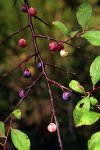
Fruit Info: For our next fruit of the day we have the hog plum, which is sometimes referred to as the sloe plum. It is native to the United States, from Virginia, down Paiute to Florida, and west to Texas. These fruits are made into Jellies and Jams.
Fruit Tier: B

November 3rd, Day 1456: Prunus rivularis
Fruit Info: This next fruit in our daily fruit series is the creek plum, also known as the hog plum. This fruit is a species of drupe. It resembles a large berry. It is found mainly in the central United States. Lastly, if you go to eat one, be warned that it has a bitter taste.
Fruit Tier: C
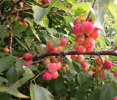
Fruit Info: This next fruit in our daily fruit series is the creek plum, also known as the hog plum. This fruit is a species of drupe. It resembles a large berry. It is found mainly in the central United States. Lastly, if you go to eat one, be warned that it has a bitter taste.
Fruit Tier: C

November 5th, Day 1458: Prunus
Fruit Info: Here we have our next fruit of the day and it is once again a member of the prunus genus. This time though it is a native of, uh, well, North America again. It goes by many different names suck as the sandhill plum, the Florida sand plum, the Chickasaw plum, and more. It is also the official fruit of the US state of Kansas.
Fruit Tier: A

Fruit Info: Here we have our next fruit of the day and it is once again a member of the prunus genus. This time though it is a native of, uh, well, North America again. It goes by many different names suck as the sandhill plum, the Florida sand plum, the Chickasaw plum, and more. It is also the official fruit of the US state of Kansas.
Fruit Tier: A


